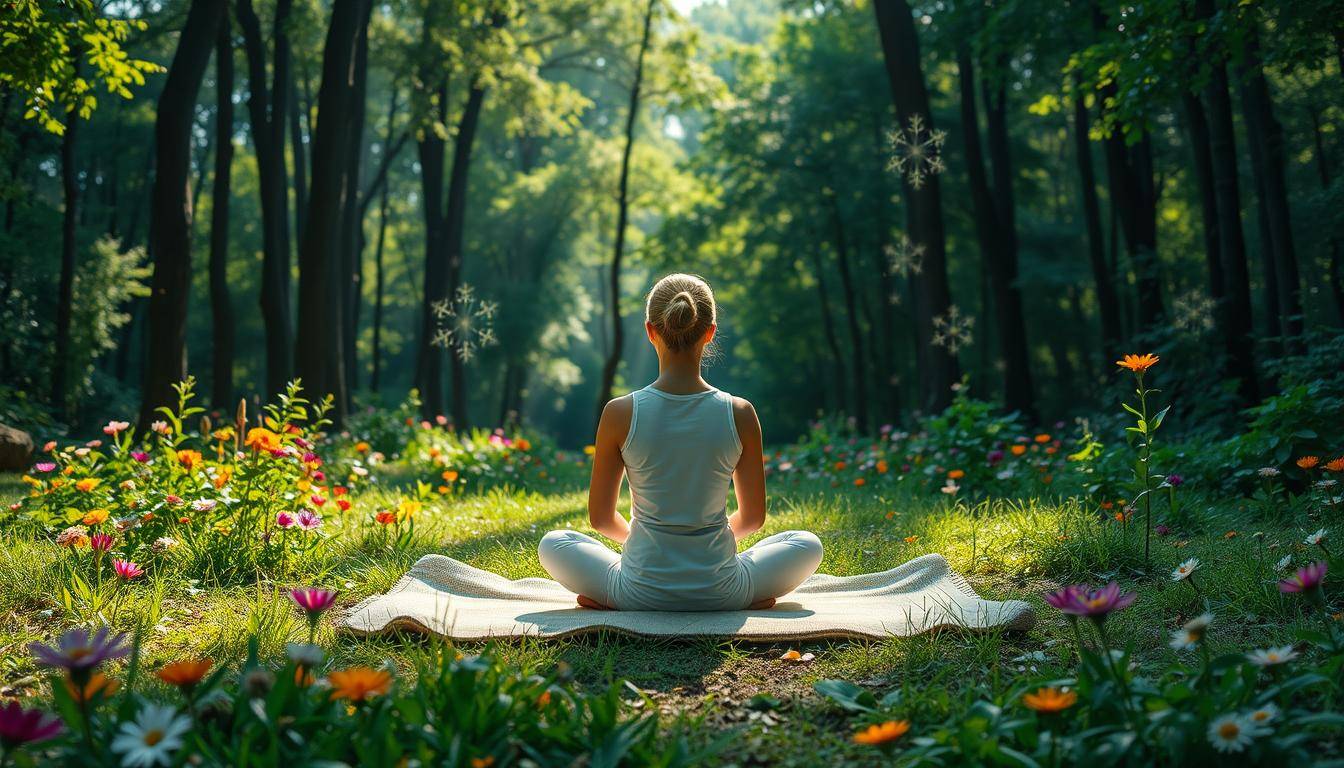“Gratitude is not only the greatest of virtues but the parent of all others.” – Marcus Tullius Cicero
Gratitude changes our lives in amazing ways. It’s about feeling thankful for all the good things around us every day. Gratitude meditation helps us find joy, attract good things, and feel better overall. It teaches us to see the good in life, making it easier to be thankful.
Starting Gratitude Meditation for Positivity is a journey of self-discovery and growth. It connects us more deeply to the world. This practice helps us focus on the good, making us more hopeful and strong.
Key Takeaways
- Gratitude meditation is a powerful tool for cultivating joy, abundance, and overall well-being.
- This practice trains the mind to focus on the positive aspects of life, making a grateful perspective more natural and effortless.
- Embracing gratitude meditation can lead to personal growth, a deeper connection with the world, and a more optimistic and resilient outlook.
- Consistent practice of gratitude meditation can transform your mindset and enhance your quality of life.
- Integrating gratitude meditation into your daily routine can help you navigate life’s challenges with greater ease and positivity.
Understanding the Power of Gratitude in Daily Life
Gratitude is a powerful emotion that can change your life. It boosts your emotional and mental health. By being thankful, you open up to many benefits that go beyond the surface.
The Science Behind Gratitude and Well-being
Studies show that gratitude strengthens your immune system and improves sleep. It also makes you feel more optimistic and joyful. Even, it can lower the risk of heart disease and help you live longer.
When you say thank you, your body releases serotonin and dopamine. These hormones make you feel good.
How Gratitude Shapes Our Perspective
Gratitude changes how you see the world. It helps you focus on the good things, not just the bad. By noticing small joys, like the sun or a good coffee, you learn to find the positive.
This mindset helps you deal with tough times better. You become more resilient and calm.
The Connection Between Gratitude and Mental Health
Gratitude is good for your mind too. It lowers anxiety and stress. It also makes your relationships stronger.
Being thankful creates a positive emotional space. It makes life more fulfilling.
“Gratitude turns what we have into enough, and more. It turns denial into acceptance, chaos into order, confusion into clarity… it makes sense of our past, brings peace for today, and creates a vision for tomorrow.”
Gratitude is truly amazing. By adding appreciation to your daily routine, you can improve your emotional and mental health. It can change your life for the better.
The Essential Components of Gratitude Meditation for Positivity
Gratitude meditation can change your life by teaching you to be thankful. It’s about thinking about the good things in your life and feeling grateful. This practice helps you see the beauty in the world around you.
Being present is a big part of gratitude meditation. It means focusing on the moment and noticing the small joys. This helps you appreciate the good things in your life more.
Expressing thanks is also key. Saying thanks for something as simple as a meal or a kind word can make you feel better. It helps you see the world as full of good things.
Doing gratitude exercises regularly can make you more thankful. Keeping a journal or thinking about what you’re thankful for can change your mind. It makes you happier and more content.
| Benefits of Gratitude Meditation | Gratitude Practices |
|---|---|
| – Improved mental and physical health – Enhanced emotional well-being – Stronger social connections – Increased feelings of abundance and contentment |
– Keeping a gratitude journal – Expressing gratitude to others – Counting blessings and appreciating small moments – Focusing on the present moment during meditation |
By using gratitude meditation, you can start a journey to a happier life. It helps you grow spiritually and feel more positive and thankful every day.
“Gratitude is the healthiest of all human emotions. The more you express gratitude for what you have, the more likely you will have even more to express gratitude for.” – Zig Ziglar
Getting Started with Your Gratitude Practice
Starting a gratitude practice can change your life for the better. It boosts your happiness and positivity. First, create a quiet space for meditation. This area should be calm and free from distractions.
Before you start, think about what you want to achieve. Maybe you want to feel happier or less stressed. Having clear goals helps your meditation be more effective.
Being regular with your meditation is important. Pick a time that fits your schedule, like morning or evening. This makes gratitude a regular part of your day.
Creating Your Sacred Meditation Space
- Find a quiet, comfy spot in your home with no distractions.
- Add things that make you feel calm, like soft lights or nice smells.
- Make sure the air is fresh and the space feels peaceful.
Setting Intentions for Your Practice
- Think about what you want to improve in your life, like feeling more joyful.
- Make specific goals, like being more thankful for your friends or family.
- Write down your goals to keep them in mind during your meditation.
Choosing the Best Time for Meditation
| Time of Day | Potential Benefits |
|---|---|
| Morning | Starts your day with a positive mindset and sets the tone for the rest of the day. |
| Evening | Allows you to reflect on the day’s blessings and end your day on a grateful note. |
Choose a time that works for you and stick to it. A dedicated space, clear goals, and a regular time make your gratitude practice powerful. This way, you can enjoy the benefits of gratitude every day.
“Gratitude meditation is a particularly powerful form of meditation that can be practiced year-round to enhance well-being.”
Simple Techniques for Cultivating an Attitude of Gratitude
Having an attitude of gratitude can change your life for the better. It boosts your emotional well-being. By doing gratitude exercises regularly, you learn to see the good in life. This leads to more happiness and fulfillment.
Keeping a gratitude journal is a great way to start. Every day, think about what you’re thankful for. It could be a friend, a good meal, or nature’s beauty. This practice helps you see the good in your life.
Also, don’t forget to express appreciation to others. Saying “Thank you” or writing a heartfelt letter can make someone’s day. It also makes you feel better about yourself.
Try to find the positive in tough times. It’s easy to get caught up in negative thoughts. But focusing on the good can keep your gratitude alive. This helps your mental health and outlook on life.
Finally, use daily gratitude affirmations. Say things like “I am grateful for what I have” or “I see the good in every situation.” This keeps your attitude of gratitude strong and positive.
By using these simple methods, you’ll grow a lasting attitude of gratitude. It will improve your emotional well-being and change your life in amazing ways.

“Gratitude is the healthiest of all human emotions. The more you express gratitude for what you have, the more likely you will have even more to express gratitude for.” – Zig Ziglar
Incorporating Mindfulness into Your Gratitude Practice
Starting a mindfulness practice can really boost your gratitude and spiritual growth. These practices together can give you deep insights, improve your self-awareness, and bring great mental health benefits.
Breathing Exercises for Deeper Awareness
Start with simple breathing exercises to become more present. Focus on the rhythm of your breath, noticing the inhalation and exhalation. Think about the air that keeps you alive and the gift of each breath. This can make you feel more grateful.
Body Scan Meditation for Gratitude
Try a body scan meditation to appreciate your amazing body. Slowly move your attention from the top of your head to your feet. Acknowledge and thank each part for letting you experience the world. Thank your body for its health and strength.
Mindful Walking with Appreciation
Take a walk and notice everything around you. See the colors, textures, and sounds. Stop to appreciate nature, your home, or the people around you. This mindful walk can make you more thankful for your life.
Adding mindfulness techniques to your gratitude practice can make you more present and aware. It can also help you grow spiritually and improve your mental health.
“When you are grateful, fear disappears and abundance appears.”
– Tony Robbins
Daily Gratitude Affirmations for Positive Transformation
Being thankful can change your life for the better. Daily gratitude affirmations help you see the good things around you. This shift can make you happier and healthier.
Begin your day with a gratitude practice. Say things like “I am grateful for the abundance in my life” or “Gratitude fills my heart and soul.” This sets a positive tone for the day. Appreciate small joys like the sun’s warmth, a stranger’s smile, or a loved one’s laugh. These moments of gratitude make you more content and thankful for now.
- I am thankful for the air I breathe and the life that flows through me.
- Each day is a gift, and I choose to embrace it with a grateful heart.
- I am grateful for the people in my life who support and uplift me.
- The beauty of nature fills me with awe and wonder.
- I am thankful for the ability to learn, grow, and expand my horizons.
Using gratitude affirmations daily can change your life. It boosts your happiness and health. It also brings more good things into your life. Let gratitude uplift your spirit and help you become the best you.
| Gratitude Affirmations for Positive Transformation |
|---|
| I am grateful for the abundance in my life. |
| Gratitude fills my heart and soul. |
| I appreciate the simple pleasures in life. |
| Every day, I find new reasons to be thankful. |
| I am surrounded by love, kindness, and blessings. |
The more you practice gratitude, the more natural it becomes. Let these affirmations change your mind, bring joy, and lead you to a life of Gratitude Meditation for Positivity.
“Gratitude can transform common days into thanksgivings, turn routine jobs into joy, and change ordinary opportunities into blessings.” – William Arthur Ward
Overcoming Challenges in Your Gratitude Journey
Starting a gratitude practice can change your life, but it’s not easy. You might face negative thoughts or lose motivation. Yet, with the right strategies, you can overcome these hurdles and enjoy the emotional well-being and mental health benefits of gratitude meditation.
Dealing with Negative Thoughts
Negative thoughts can block your gratitude practice. It’s key to accept these thoughts and shift your focus to the good things in life. Mindfulness and kindness to yourself can help you handle these moments better.
Maintaining Consistency in Practice
Keeping up with gratitude can be tough, especially when life gets busy. To stay on track, use reminders, have a special spot for your practice, and make gratitude a daily habit. The more you practice, the more natural it becomes.
Building Resilience Through Gratitude
Gratitude helps you stay strong, especially when things get tough. By focusing on the positive, you build a sense of emotional well-being and perspective. This helps you face challenges with more ease and positivity.
Gratitude’s journey has its ups and downs, but facing these challenges is worth it. Keep going, and you’ll see the amazing benefits of an attitude of gratitude in your life.
The Role of Journaling in Gratitude Meditation
Journaling is key in gratitude meditation. It keeps a record of good things and experiences. Writing down what you’re thankful for helps you stay grateful. It also helps during tough times.
Studies show that writing down what you’re thankful for boosts your mental health. People who do this often feel better about themselves and have less depression and anxiety.
Gratitude journaling also helps your body. People who are grateful often have fewer health problems. They might even have better heart health and lower blood pressure.
To make the most of journaling, be specific and detailed. Writing about why you’re grateful for something is more helpful than just listing things. Thinking about what you don’t have can also make you appreciate what you do have more.
Experts say to write in your gratitude journal at least once or twice a week. This keeps the practice fresh and powerful. It helps you stay focused on the positive.

“Gratitude unlocks the fullness of life. It turns what we have into enough, and more. It turns denial into acceptance, chaos into order, confusion into clarity… Gratitude makes sense of our past, brings peace for today, and creates a vision for tomorrow.” – Melody Beattie
Adding gratitude journaling to your daily routine can change your life. It helps you appreciate more and grow as a person.
Building Meaningful Connections Through Grateful Living
In the journey of cultivating joy, emotional well-being, and spiritual growth, showing gratitude is key. Expressing thanks to those around you can make relationships stronger. It also helps build a sense of community and encourages others to be thankful.
By sharing your gratitude story, you help yourself and others. It’s a way to motivate and uplift everyone around you.
Expressing Gratitude to Others
Showing genuine gratitude is a powerful way to connect with others. A simple “thank you” can mean a lot to someone. It can be to a family member, a colleague, or a mentor.
Studies show that being thankful improves both your emotional and physical health. It can lower blood pressure and help you sleep better.
Creating a Gratitude Community
Being part of a gratitude group can be incredibly helpful. It keeps you motivated and introduces you to new ways to be thankful. You can find groups online or in your area.
These communities offer support and a sense of belonging. They show the power of living a grateful life.
Sharing Your Journey with Others
Talking about your gratitude journey can inspire others. Sharing your experiences helps people see the real impact of gratitude. It shows that happiness can spread.
Research shows that being around happy people can make you happier too. Your story could be the spark someone needs to start their own journey of gratitude.
As you live a life filled with gratitude, remember your actions matter. They help build strong connections, create supportive communities, and inspire others to find happiness and spiritual growth.
Measuring Your Progress and Celebrating Growth
Starting your Gratitude Meditation for Positivity journey is exciting. It’s key to track your progress and celebrate your wins. Seeing how your gratitude practice affects your mental health and relationships keeps you motivated.
Begin by noting your mood, stress levels, and relationship quality. Reflecting on these every Sunday can show how your Gratitude Meditation for Positivity is improving your mental health benefits and positive psychology. Celebrate any small improvements, as they show the strength of your practice.
Recognizing and valuing your growth is a form of gratitude itself. It strengthens the benefits of your meditation journey. Stay dedicated, and you’ll see how gratitude changes your life over time.
FAQ
What is gratitude meditation and how can it transform my life?
Gratitude meditation is a powerful practice. It involves reflecting on the good things in your life. This can make you happier, attract more good things, and improve your well-being.
How does gratitude impact my mental health and well-being?
Studies show that gratitude boosts mental health. Focusing on the good in your life can change your outlook. It helps you stay positive, even when things are tough.
What are the key components of a gratitude meditation practice?
Key parts of gratitude meditation include being present and noticing both big and small blessings. Regularly practicing gratitude exercises helps you grow spiritually and stay positive.
How do I get started with a gratitude meditation practice?
Start by creating a calm space for meditation. Set goals for your practice, like feeling happier or less stressed. Choose a regular time for meditation, like morning or evening.
What are some techniques for cultivating an attitude of gratitude?
To cultivate gratitude, try keeping a gratitude journal or thanking others. Focus on the good in tough situations. Daily affirmations can also help your mind become more grateful.
How can I incorporate mindfulness into my gratitude practice?
Mindfulness makes gratitude stronger by focusing on the present. Try breathing exercises, body scans, or walking mindfully. These practices deepen your gratitude and improve your mental health.
What are the benefits of daily gratitude affirmations?
Daily affirmations like “I am grateful for abundance” can change your mind for the better. They boost your well-being and attract more positive experiences.
How can I overcome challenges in maintaining a gratitude practice?
Overcoming challenges like negative thoughts and staying consistent is key. Acknowledge negative thoughts, set reminders, and focus on gratitude even when it’s hard.
Why is journaling an important part of gratitude meditation?
Journaling records your blessings and positive experiences. It reinforces grateful thinking and helps you reflect on growth. It’s especially helpful during tough times.
How can I build meaningful connections through grateful living?
Grateful living strengthens relationships by expressing thanks and creating supportive communities. Sharing your gratitude journey with others inspires and supports you.
How can I track my progress and celebrate growth in my gratitude practice?
Track your progress by noting changes in your mood and relationships. Celebrate every small victory. Regular self-reflection keeps you motivated and shows the positive changes gratitude brings.




























































